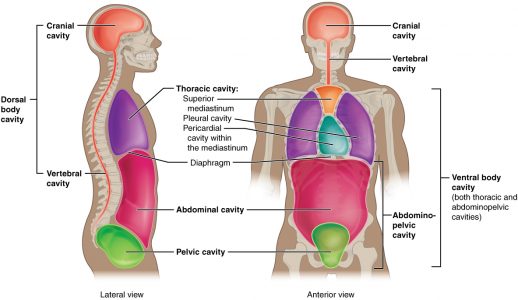Ventral Cavity Definition
The ventral cavity, or ventral body cavity, is a fluid filled space surrounding the organs on the ventral side of humans and other tetrapods. The ventral cavity is one of two main cavities, the other being the dorsal cavity. The ventral cavity, in humans, is actually made up of two separate cavities, separated by the diaphragm, a thin muscle which helps control the expansion and contraction of the lungs.
The ventral cavity is sometimes referred to as a coelom, or true body cavity. While not all coelomates have a well-defined ventral cavity as in humans, all ventral cavities are coeloms. The coelom is a generic body cavity developed within a number of animal phyla, which is a “true cavity” in the sense that all surfaces are lined with a special membrane, sealing off the cavity from other parts of the body.
Function of the Ventral Cavity
Like all body cavities, the ventral cavity has several important functions relating to the organs housed within in. First and foremost, the cavity protects the organs inside from shock damage as the organism moves through the world. The space and fluid around the organs insures that any impacts incurred by the organism will not be transferred onto the organs. This protective function of the cavity is present in many different animals, even fish have a protective ventral cavity surrounding their organs.
A function which is used more by animals with lungs is expansion, or the ability of the ventral cavity to change shape, allowing the expansion of certain organs. In humans, the ventral cavity must expand in several places to allow for various organs to expand and change shape. In the superior (top) portion of the ventral cavity, the lungs need room to expand and take in air. In the inferior (lower) portion, the stomach and intestines need room to expand when taking in food, as well as the bladder when storing urine. Both the organs and the ventral cavity walls are lined with peritoneum, a thin membrane which separates the cavity from the inside of the body. The organs are also lined with a peritoneum, protecting them from rubbing on the inside of the cavity. Together, this creates a system which allows the organs to slide seamlessly past one another as the body moves about.
Human Ventral Cavity
Below is an image of the cavities within the human body. The ventral cavity is actually made up of several different cavities, which are separated by muscles and membranes. These smaller cavities are divided into two segments, the thoracic cavity and the abdominopelvic cavity.
Thoracic Cavity
The human ventral cavity is divided into two main parts, the thoracic cavity and the abdominopelvic cavity. The thoracic cavity is further divided into separate parts. Two pleural cavities, the left and right, hold the lungs. A central membrane, the mediastinum, divides these two chambers. The heart sits within the pericardial cavity. This cavity protects the heart from damage and allows it to beat without rubbing on the lungs and body tissues.
Below this portion of the cavity lies the diaphragm, a thin muscle. The diaphragm, when it contracts, pushed upward on the lungs, forcing the air out. The ribs, forming the outside of the ventral cavity, also squeeze together to force the air out. In this way, all the carbon dioxide rich air sitting in the lungs can be forcefully expelled outward, while oxygen-laden air can be drawn in afterwards and be taken into the bloodstream. The ventral cavity expanding and contracting is what works the lungs, as the lungs themselves are essentially a mucous membrane wrapped around blood vessels.
Abdominopelvic Cavity
The inferior portion of the ventral cavity is the abdominopelvic cavity. This sits below the diaphragm, and can be subdivided into two areas. The abdominal cavity sits on top, while pelvic cavity sits below. The abdominal cavity houses the stomach, small intestines, most of the large intestines, kidneys, spleen, and liver. The pelvic cavity houses the internal reproductive organs and the bladder, while the large intestine briefly passes through it.
The abdominopelvic portion of the ventral cavity also must expand and contract. The walls of the abdomen have thick muscles, mostly for moving the body. However, these muscles push and work on the internal organs in the cavity, stimulating them and moving food and fluids through the system. Further, the abdominal cavity of many animals can expand a great deal, allowing for massive meals to be consumed. A python, for instance, can swallow prey several times the size of its head. The ventral cavity must also expand to deal with this massive meal.
Quiz
References
- Brusca, R. C., & Brusca, G. J. (2003). Invertebrates. Sunderland, MA: Sinauer Associates, Inc.
- Feldhamer, G. A., Drickamer, L. C., Vessey, S. H., Merritt, J. F., & Krajewski, C. (2007). Mammology: Adaptation, Diversity, Ecology (3rd ed.). Baltimore: The Johns Hopkins University Press.
- Widmaier, E. P., Raff, H., & Strang, K. T. (2008). Vander’s Human Physiology: The Mechanisms of Body Function (11th ed.). Boston: McGraw-Hill Higher Education.

